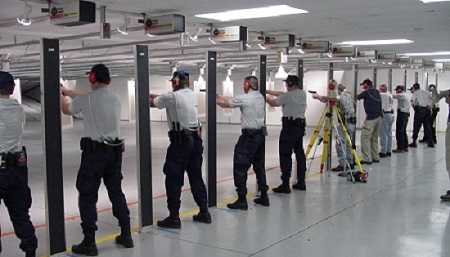Indoor Firing Ranges
Overview
Indoor firing ranges are popular among law enforcement and recreational shooters because they offer protection from inclement weather conditions and can be operated around the clock under controlled environmental conditions. However, many firing range facilities lack environmental and occupational controls to protect the health of shooters and range personnel from effects of airborne lead, noise, and other potential exposures.
This page provides links to information about the evaluation, measurement, and control of noise and airborne lead exposures at indoor firing ranges.

Spotlights
- Follow us @NIOSH_FirRanges on Twitter
- Indoor Firing Ranges and Elevated Blood Lead Levels — United States, 2002–2013
- OSHA cites Henry RAC Holding Corp, a small arms manufacturer, $72,000 for exposing workers to lead and noise
- OSHA cites Illinois Gun Works $111,000 for exposing workers to noise and lead
NIOSH Publications
Preventing Occupational Exposures to Lead and Noise at Indoor Firing Ranges
DHHS (NIOSH) Publication No. 2009-136
This Alert presents five case reports that document lead and noise exposures of law enforcement officers and students. The Alert examines firing range operations, exposure assessment and control methods, existing regulations, and exposure standards and guidelines.
Reducing Exposure to Lead and Noise at Indoor Firing Ranges
NIOSH Publication No. 2010-113
This two-page Workplace Solutions document provides clear and simple recommendations to workers, occupational shooters, and operators of indoor firing ranges to reduce their occupational exposure to airborne lead and high-intensity noise.
Reducing Exposure to Lead and Noise at Outdoor Firing Ranges
NIOSH Publication No. 2013-104
This two-page Workplace Solutions document provides clear and simple recommendations to workers, occupational shooters, and operators of outdoor firing ranges to reduce their occupational exposure to airborne lead and high-intensity noise.
Lead exposure and design considerations for indoor firing ranges
DHHS (NIOSH) Publication No. 76-130 (December 1975)
This technical document provides the user with recommendations for design considerations and work practices to reduce or eliminate health hazards associated with indoor firing ranges. It includes topics such as ventilation, noise, and maintenance issues.
Peer-Reviewed Publications
Indoor Firing Ranges and Elevated Blood Lead Levels - United States, 2002-2013
Auditory risk estimates for youth target shooting
Int J Audiol 2014 Mar; 53(S2):S16-S25
Noise exposure profiles for small-caliber firearms from 1.5 to 6 meters
J Acoust Soc Am 2012 Sep; 132(3)(Pt. 2):1905
Noise mitigation at the Combat Arms Training Facility, Wright Patterson Air Force Base, Dayton, OH
J Acoust Soc Am 2012 Sep; 132(3)(Pt. 2):2084
Measurement of impulse peak insertion loss for four hearing protection devices in field conditions
Int J Audiol 2012 Feb; 51(S1):S31-S42
Handwipe method for removing lead from skin
J ASTM Int 2011 May; 8(5):JAI103527
Evaluation of a handwipe disclosing method for lead
J ASTM Int 2011 Apr; 8(4):1-7
Measurement of impulse peak insertion loss for five hearing protectors
J Acoust Soc Am 2011 Apr; 129(4)(Part 2):2651
Noise control solutions for indoor firing ranges
Noise Control Eng J 2010 Jul; 58(4):345-356
Assessment of noise exposure for indoor and outdoor firing ranges
J Occup Environ Hyg 2007 Sep; 4(9):688-697
Firearms and hearing protection
Hearing Rev 2007 Mar; 14(3):36, 38
Lead Exposure from Indoor Firing Ranges Among Students on Shooting Teams --- Alaska, 2002—2004
NIOSH/NHCA best-practices workshop on impulsive noise
Noise Control Eng J 2005 Mar-Apr; 53(2):53-60
Noise exposure assessment and abatement strategies at an indoor firing range
Appl Occup Env Hyg 2003 Aug; 18(8):629-636
Indoor Shooting Ranges
ASHARE Journal 2002 Dec; 44-48
Ventilation control of lead in indoor firing ranges: inlet configuration and booth and fluctuating flow contributions
Am Ind Hyg Assoc J 1991 Feb; 52(2):81-91
Reducing Exposures to Airborne Lead in Indoor Firing Ranges -- United States
For more publications, see:
NIOSHTIC-2 search results on Firing Ranges
NIOSHTIC-2 is a searchable bibliographic database of occupational safety and health publications, documents, grant reports, and journal articles supported in whole or in part by NIOSH.
NIOSH Health Hazard Evaluations
NIOSH conducts Health Hazard Evaluations (HHEs) to find out whether there are health hazards to employees caused by exposures or conditions in the workplace.
Some recent HHE reports related to firing ranges have been listed below. For a comprehensive listing of HHE reports please search the HHE Database .
Health Hazard Evaluation Report: HETA 2013-0119-3219, Lead Exposure at a Firing Range and Gun Store
Health hazard evaluation report: HETA-2005-0153-2997, Markham Park, Broward County Parks and Recreation Division, Sunrise, Florida [PDF - 930 KB]
Health hazard evaluation report: HETA-2002-0131-2898, Fort Collins Police Services, Fort Collins, Colorado [PDF - 636 KB]
Health hazard evaluation report: HETA-2000-0191-2960, Immigration and Naturalization Service, National Firearms Unit, Altoona, Pennsylvania [PDF - 1,393 KB]
Health hazard evaluation report: HETA-1997-0255-2735, Forest Park Police Department, Forest Park, Ohio [PDF - 254 KB]
Health hazard evaluation report: HETA-1996-0218-2623, New Hampshire Police Standards and Training Council, Concord, New Hampshire [PDF - 231 KB]
Health hazard evaluation report: HETA-1996-0107-2613, Dartmouth Police Department, Dartmouth, Massachusetts [PDF - 215 KB]
Health hazard evaluation report: HETA-1992-0034-2356, Saint Bernard Police Department, Saint Bernard, Ohio [PDF - 215 KB]
Health hazard evaluation report: HETA-1991-0346-2572, FBI Academy, Quantico, Virginia [PDF - 325 KB]
Other Resources
Potential Health Risks to DOD Firing-Range Personnel from Recurrent Lead Exposure
Range Design Criteria: U.S. Department of Energy: Office of Health, Safety and Security
Lead Management and OSHA Compliance for Indoor Shooting Ranges
Guidance Document: Indoor Firing Range Design and Operations Criteria Version 2.0
Contact Us
- NIOSH Toll-Free Information Inquiry Service
1-800-CDC-INFO (1-800-232-4636)
Outside the U.S. 513-533-8328
Email: NIOSH Firing Range
1-888-232-6348 TTY
In English, en Espanol
24 Hours/Day, 7 Days/Week - Email NIOSH with your questions or concerns on exposures to lead and noise at indoor firing ranges
This is an occupational safety and health information service
and not a hotline for medical emergencies.
- Page last reviewed: August 15, 2013
- Page last updated: August 29, 2014
- Content source:
- National Institute for Occupational Safety and Health Division of Applied Research and Technology


 ShareCompartir
ShareCompartir